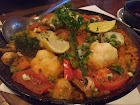We may well have stumbled across the world's best kept secret. When it comes to diversity of landscape and wildlife, look no further. From snow-capped volcanoes, rocky deserts, endless plains, alpine lakes and dense jungle to two toed sloths, hummingbirds, capybaras, jaguars and harlequin frogs...Colombia is considered to be the most prolific biosphere on earth. Having suffered a terrible reputation of crime and violence, Colombia has cleaned up its act, and is very proud of the huge progress they have made in stabilising their country socially, economically and politically.
If you need further testament to the wealth of wildlife, then look up. Colombia has the largest bird list in the world, with 1872 species of avifauna filling their sky. And if bird-watching is not your thing, intellectual Bogota ( the capital) will oblige: cutting-edge art, experimental theatre, vibrant Latin music scene and of course food. Colombian cuisine is a blend of European and native ingredients. It is extremely diverse, and most people would not know what the traditional food of Colombia encompasses. It varies greatly from northeast to southwest, but one thing is for certain - they love meat, and lots of it. Many consider Bandeja Paisa to be the national dish - a platter filled with steak, pork crackling and chorizo sausages, accompanied by beans, rice, avocado and sweet banana chips, topped off with a fried egg....not for the faint-hearted. Another speciality is Lechona - a whole pig, stuffed with rice, peas, onions and spices, then roasted in a clay oven for 10 hours. And if you prefer to indulge in a local phenomenon, try the Hormigas Culonas (queen ants - wings and legs removed, soaked in salt water, then roasted - literally translated: big ass-ants). Arepa is a cornmeal bread served with every main meal, and for snacking, you can't go past a delicious, stuffed and fried (as opposed to baked in most other South-American countries ) Empanada.
To experience the taste of Colombia, we travelled to Woolloongabba, 2km south of the CBD (see suburb history and profile week 9: France) to Evo Colombian Restaurant. Brothers Sam, Luis and Carlos fulfilled a lifelong dream when they opened Evo. Mum Teresa lends a helping hand in the kitchen, bringing the traditional flavours of her homeland to every dish. Que aproveche! Last night was terribly windy and very cold, so the blankets draped over the back of each chair came in very handy (albeit that we sat inside). Friday night is Tapas night. Showcasing the strong Spanish connection with a Colombian touch, the seven of us ordered a selection of share-plates: Empanadas (stuffed with potato and herbs), chorizo sausages in red wine, garlic infused mushrooms, salty fried king prawns, baby octopus, and a vegetarian paella. This went down well with some Colombian beer and a couple of glasses of red wine. For a more authentic experience, rather visit Evo on a Sunday, when they serve a full Colombian feast. There are just over 21,000 Colombians living in Australia - the largest group of immigrants from South America- most settling here during the troubled times experienced in Colombia in the 1980's. Unlike other countries in the region, the Colombians who move to Australia are mostly urban and educated (part of the significant brain-drain of the country). Many of them choose Brisbane, and this Sunday (20 July) will see the first Colombian Independence Day Festival in Fortitude Valley when food, drink, music, salsa and cumbia will bring Carnival to town.
No Friday Night Out is complete without the sharing of facts - and there were many. The biodiversity was discussed at length. Colombia (named after its founder, Christopher Columbus) has over 162 species of Hummingbirds ( the only bird that can fly backwards), the Andean Condor is the national animal, and the capybara is a barrel-shaped, giant, semi-aquatic rodent that lives on the river banks. We discussed the building and cost of the Panama Canal, and the proposed Colombia-China joint venture to build a rail alternative to boost trade. We touched on the legendary lost city of gold, El Dorado, and briefly mentioned the coffee trade. A positive story, is that Colombia is no longer the world's largest producer of cocaine. This title now belongs to Peru. And Jane concluded with a few Colombian rules of social engagement : eye contact, handshakes and family history - all very important preambles to a meaningful meeting ( probably to determine on which side of the thin white line your allegiance lies, we decided....).
And how can we conclude Colombia without mentioning the most significant revelation of the World Cup Football: James (pronounce HAHM-ez) Rodrigues - the new pin-up boy of soccer. With a kiss on both cheeks from our delightful young waiter Rodolfo, we departed filled with Latin-American cheer.
We say farewell to Andrew and Jane, who return to South Australia after joining us on four of our culinary expeditions. Adios!
And we welcome the prospect of travelling to our first (and only) Scandinavian destination - next week we'll see you in Denmark !






 James Rodriquez
James Rodriquez







No comments:
Post a Comment